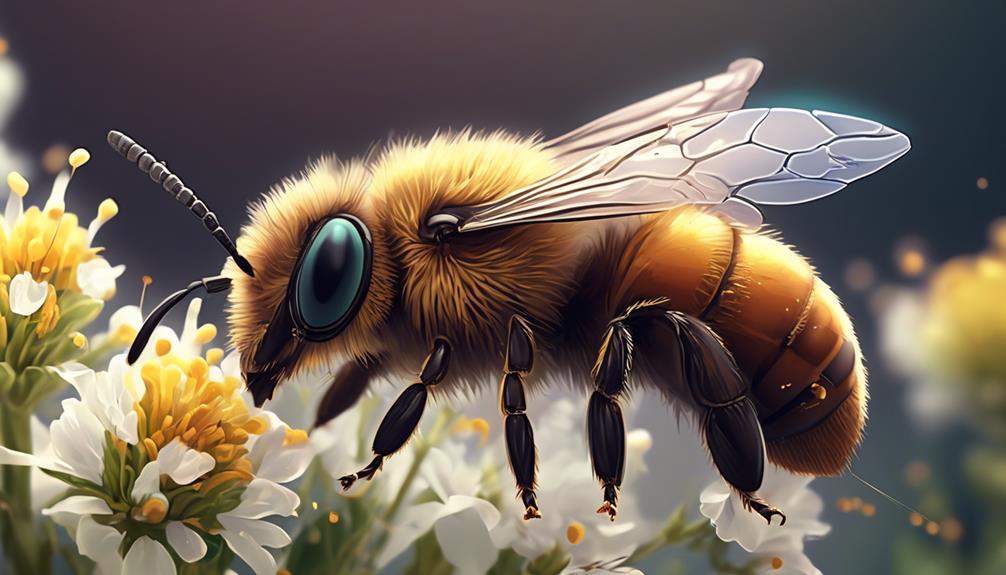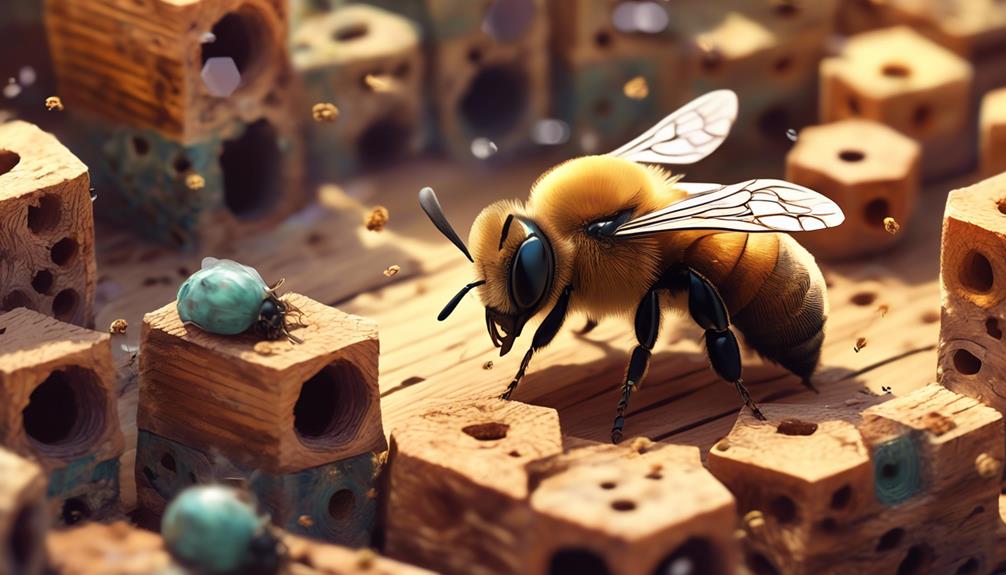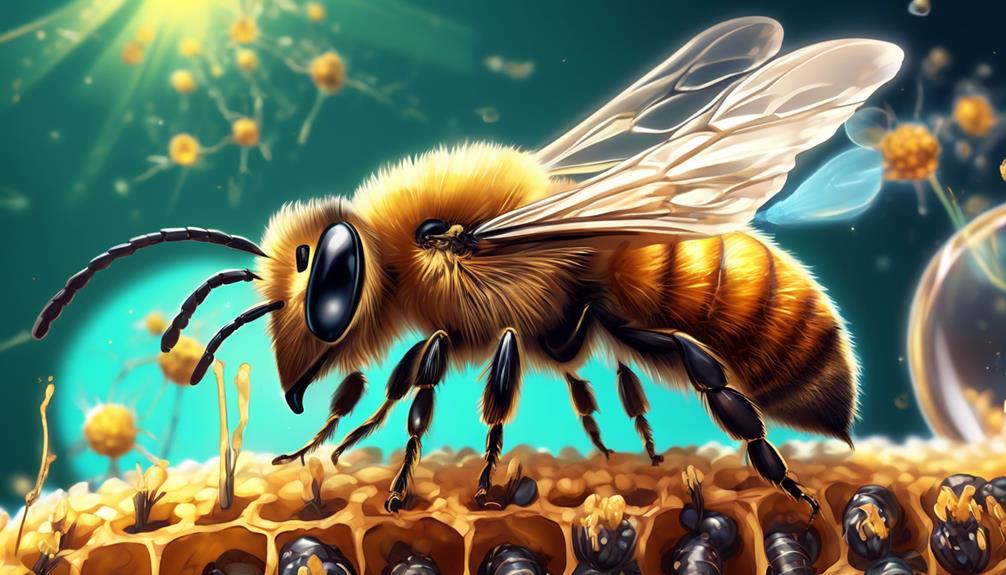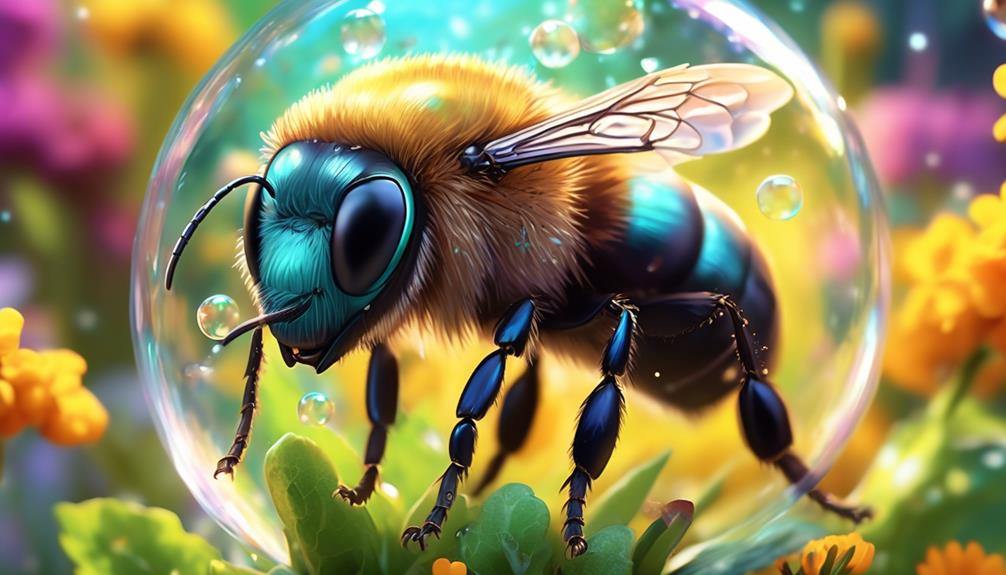Observe the fascinating world of mason bees and their unique relationship with varroa mites; discover the unexpected answers in this intriguing exploration.

Do Mason Bees Get Varroa Mites?
You might not be aware, but there's a world of difference between mason bees and the more commonly known honey bees, especially when it comes to infestations by varroa mites.
While you're likely familiar with the devastating impact these parasites have on honey bee populations, the question arises – can these mites infect the less-known, but equally vital, mason bees?
The answer to this question is not as straightforward as you might think and involves understanding the unique biology and behavior of mason bees.
So, why not stick around to uncover this intriguing aspect of the bee world?
Key Takeaways
- Mason bees are susceptible to infestations by varroa mites, which can have devastating effects on their health and lifespan.
- Varroa mites feed on the hemolymph of mason bee larvae and can transmit deadly diseases.
- Mason bees have some natural defenses against varroa mites, such as shorter brood cycles and nest sanitation behavior.
- Regular hive inspections, strategic habitat placement, and the use of natural remedies can help protect mason bees from varroa mite infestations.
Understanding Mason Bees

To truly grasp the nature of mason bees, you've got to delve into their unique characteristics, life cycle, and the pivotal role they play in ecosystems. Unlike honeybees, mason bees are solitary insects that don't live in a hive or produce honey. They're named for their unique nesting behaviour, where they use mud to create individual cells for their larvae inside pre-existing holes.
In terms of lifespan, most mason bees live for around one year. They emerge from their cocoons in early spring, mate, and then the females begin their solitary work of building and provisioning nests. After laying an egg in each cell, they seal it with mud, hence their name. The larvae hatch, feed on the stored food, and grow until they pupate, overwinter, and emerge as adults the following spring.
Mason bees play a crucial role in pollination. They're considered more efficient pollinators than honeybees because they carry pollen on their belly and deposit it directly onto the pistil of flowers. This ensures the transfer of a large amount of pollen, boosting the productivity of crops and wild plants.
Understanding these bees is vital to promote biodiversity and maintain ecosystem balance.
The Threat of Varroa Mites

While mason bees are a boon to ecosystems, they're not immune to the threat posed by Varroa mites, tiny parasites that can wreak havoc on their populations. These mites latch onto bees, sucking their blood and transmitting deadly diseases. They're particularly harmful to bee larvae, which can lead to a significant decrease in bee populations.
Here's a more detailed look at the impact of Varroa mites:
Threat | Impact on Bees | Possible Outcome |
|---|---|---|
Blood-sucking | Weakens bees, reduces lifespan | Decreased bee population |
Disease transmission | Causes fatal diseases like Deformed Wing Virus | High bee mortality rates |
Impact on larvae | Kills immature bees | Fewer bees, disrupted pollination |
Resistance to treatments | Varroa mites can become resistant to chemical treatments | Continued spread of mites |
Spread to other hives | Mites can move from one bee to another, spreading across hives | Widespread bee population decline |
Mason Bees Vs. Honey Bees

Diving into the world of bees, you'll find notable differences between mason bees and honey bees that significantly impact their respective susceptibilities to threats like Varroa mites.
Mason bees, solitary in nature, create individual nests, while honey bees live in large, communal hives. This fundamental dissimilarity influences their exposure to mites.
Varroa mites thrive in honey bee hives due to the close proximity of the bees, facilitating easy transmission of mites and associated diseases. Conversely, mason bees' solitary nests limit the spread of these parasitic mites.
Furthermore, honey bees and mason bees differ in their brood cycles. Honey bees, possessing a longer brood cycle, provide an extended breeding ground for mites. On the contrary, mason bees' shorter cycle doesn't offer the same opportunity for mite reproduction, reducing their susceptibility.
Lastly, mason bees display a unique behavior known as nest sanitation. They meticulously clean their nests before laying eggs, reducing mite survival chances. Honey bees don't exhibit this trait, making them more vulnerable to infestations.
Varroa Mite Infestation in Mason Bees

Despite the reduced susceptibility of mason bees to Varroa mites, infestations can still occur with potentially devastating effects. If you're not vigilant, mites can infiltrate the bee's habitat, latch onto larvae, and feed on their hemolymph – the bee equivalent of blood.
In analyzing the infestation dynamics, it's crucial to understand that Varroa mites reproduce in brood cells. They infiltrate the cells just before they're sealed, and while inside, they lay eggs that feed on the bee larva. By the time the adult bee emerges, the mite's offspring are ready to infest other cells, perpetuating the cycle.
What's alarming is that Varroa mites are vectors for various bee pathogens, including deformed wing virus. This can lead to a colony collapse if not managed properly. Hence, monitoring and early detection are paramount in your beekeeping practices.
Interestingly, mason bees' solitary nature and shorter brood cycle may offer some natural protection against extensive infestation. However, don't let this lull you into complacency. It's essential to maintain proactive measures to ensure the health of your mason bee population. After all, these pollinators are vital to our ecosystems.
Protecting Mason Bees From Parasites

In your quest to safeguard your mason bees from parasites, it's crucial to implement a comprehensive and proactive approach that encompasses regular hive inspections, strategic habitat placement, and the use of natural remedies.
Regular hive inspections are key to early pest detection. You should look for signs of distress, such as lethargic behavior or physical indications of infestation like mites or larval sacs on the bees. It's also advisable to inspect the hive structure for any abnormalities.
Strategic habitat placement serves dual purposes. Firstly, it can deter parasites by positioning the hive in an area with less exposure to carrier insects. Secondly, it can promote healthier bees by providing ample access to food sources, thus boosting their immune systems.
Natural remedies such as thyme oil or powdered sugar can help repel or kill parasites without harming the bees. However, it's important to use these remedies judiciously, as overuse can lead to resistance in parasites.
Lastly, consider rotating your bee populations, replacing old bees with new ones, to break the life cycle of parasites. This integrated approach can ensure the health and longevity of your mason bees.
Conclusion
In conclusion, you'll find that mason bees aren't typically plagued by varroa mites, unlike their honey bee counterparts.
However, this doesn't mean they're entirely immune to parasites.
It's essential to monitor your local mason bee population and provide them with suitable habitats.
By understanding and addressing the threats they face, you're not only aiding in their survival but also contributing to a healthier ecosystem.



